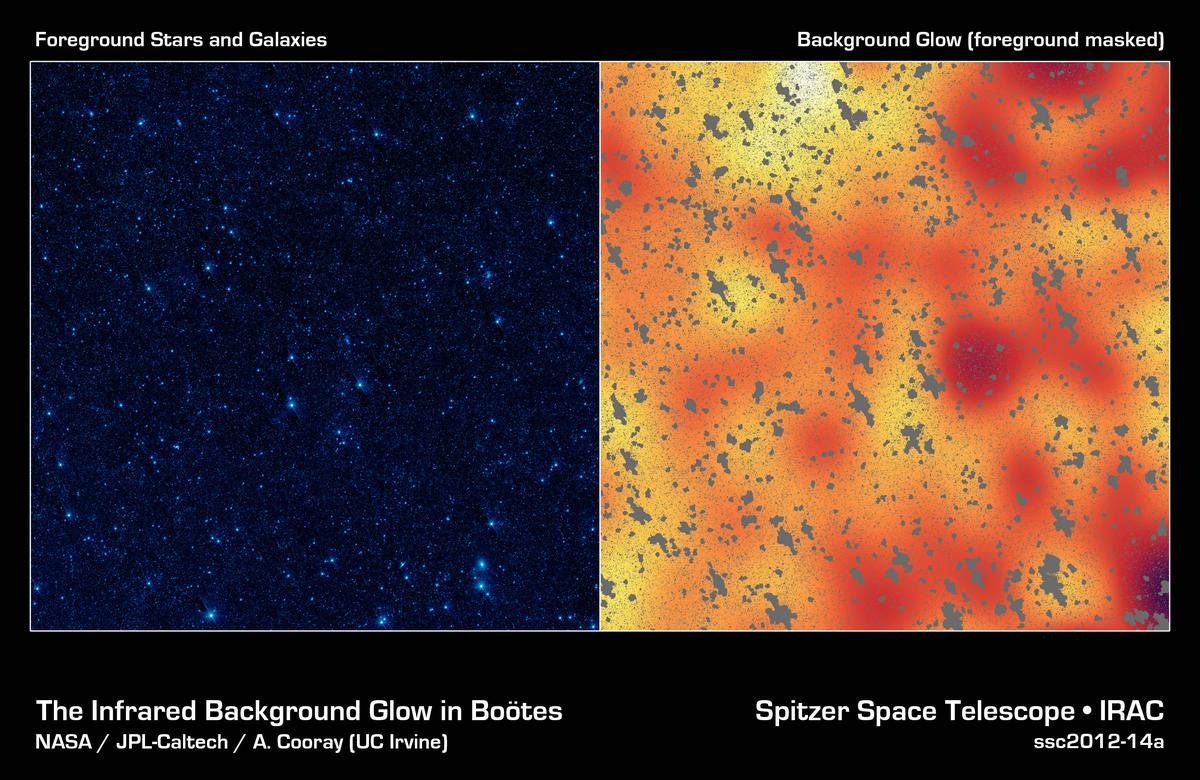When looking at the cosmos, astronomers have seen what are neither stars nor galaxies nor a uniform dark sky but mysterious, sandpaper-like smatterings of light, what UCLA professor of physics and astronomy Edward L. (Ned) Wright refers to as "fluctuations".
The debate has centered around the source of those fluctuations. One explanation is that the fluctuations in the background are from very distant unknown galaxies. Another explanation is that they're from unknown galaxies that are not so far away, but the fluctuations have been traveling to us from faint galaxies for only 4 or 5 billion years - a rather short time in astronomy terms. Researchers in a new paper say that both those explanations are wrong and they propose an alternative.
The first explanation — that the fluctuations are from very distant galaxies — is nowhere close to being supported by the data from NASA's Spitzer Space Telescope, says Wright. "The idea of not-so-far-away faint galaxies is better, but still not right. It's off by a factor of about 10; the 'distant galaxies' hypothesis is off by a factor of about 1,000."
Lead author Asantha Cooray, a UC Irvine professor of physics and astronomy, and colleagues contend that the small number of stars that were kicked to the edges of space during violent collisions and mergers of galaxies may be the cause of the infrared light "halos" across the sky and may explain the mystery of the excess emitted infrared light. As crashing galaxies became gravitationally tangled with one another, "orphaned" stars were tossed into space. It is these stars, the researchers say, that produce the diffuse, blotchy scatterings of light emitted from the galaxy halos that extend well beyond the outer reaches of galaxies.

On the left is a portion of our sky called the Boötes field, in infrared light, on the right shows a mysterious, background infrared glow captured by NASA's Spitzer Space Telescope in the same region of sky. Using Spitzer, researchers were able to detect this background glow, which spreads across the whole sky, by masking out light from galaxies and other known sources of light. (The masks are the gray, blotchy marks). They say that this light is coming from stray stars that were torn away from galaxies. When galaxies tangle and merge, stars often get kicked out in the process. The stars are too faint to be seen individually, but Spitzer may be seeing their collective glow. Credit: NASA/JPL-Caltech/UC Irvine)
"Galaxies exist in dark matter halos that are much bigger than the galaxies; when galaxies form and merge together, the dark matter halo gets larger and the stars and gas sink to the middle of the the halo," says Wright. "What we're saying is one star in a thousand does not do that and instead gets distributed like dark matter. You can't see the dark matter very well, but we are proposing that it actually has a few stars in it — only one-tenth of 1 percent of the number of stars in the bright part of the galaxy. One star in a thousand gets stripped out of the visible galaxy and gets distributed like the dark matter.
"The dark matter halo is not totally dark. A tiny fraction, one-tenth of a percent, of the stars in the central galaxy has been spread out into the halo, and this can produce the fluctuations that we see."
In large clusters of galaxies, astronomers have found much higher percentages of intra-halo light, as large as 20 percent, they contend. For their analysis, they used the Spitzer Space Telescope to produce an infrared map of a region of the sky in the constellation Boötes. The light has been traveling to us for 10 billion years.
"Presumably this light in halos occurs everywhere in the sky and just has not been measured anywhere else," said Wright. "If we can really understand the origin of the infrared background, we can understand when all of the light in the universe was produced and how much was produced. The history of all the production of light in the universe is encoded in this background. We're saying the fluctuations can be produced by the fuzzy edges of galaxies that existed at the same time that most of the stars were created, about 10 billion years ago.
"What we really need to be able to do is to see and identify the galaxies that are producing all the light in the infrared background. That could be done to a much greater extent once the James Webb Space Telescope is operational because it will be able to see much more distant, fainter galaxies."
Published in Nature





Comments